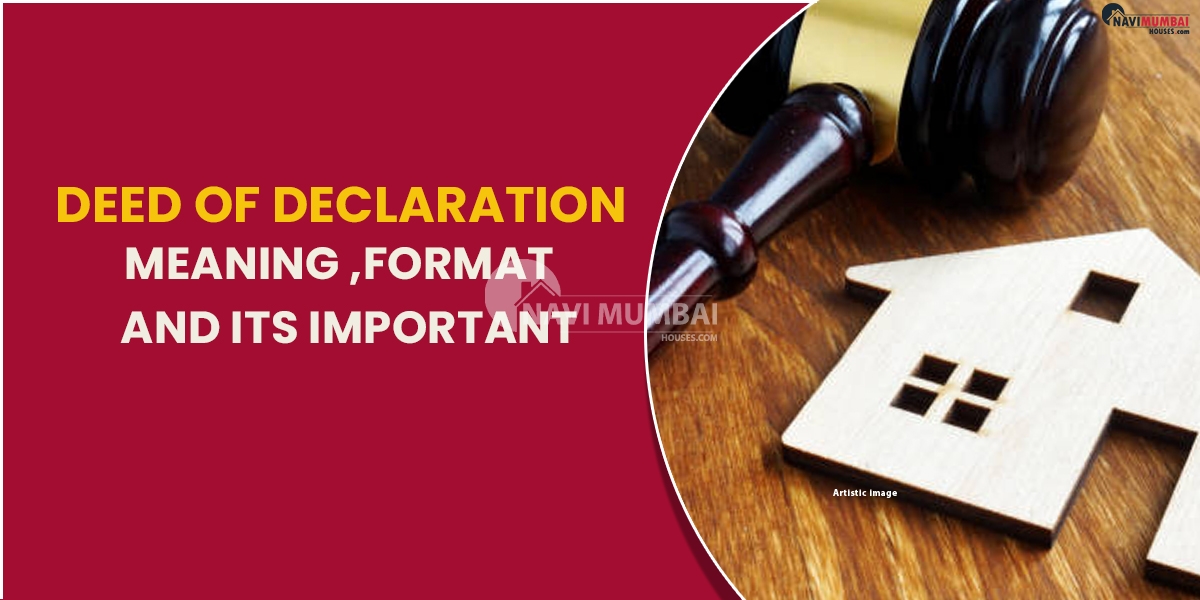
- October 11, 2023
- Finance & Legal, News
Deed Of Declaration Meaning ,Format And Its Important
Introduction Deed Of Declaration
Deed of declaration when it comes to shared assets like condominiums, housing societies, or planned communities, real estate ownership can be a complicated issue. The Deed of Declaration, a legal document, is essential to the efficient governance and management of such properties. This text outlines the rights and duties of property owners and establishes the groundwork for the management and operation of these shared places. We will examine the significance of a Deed of Declaration in property management as well as its meaning, components, legal structure, and crucial value in this extensive guide.
Are you looking for new projects in Shilphata ?
Understanding The Declaration Of Independence
A Deed of Declaration, also known as a Declaration of Covenants, Conditions, and Restrictions (CC&R), is a legally enforceable agreement that lays out the guidelines and restrictions that apply to all properties included in a common area. It frequently pertains to real estate like condominiums, townhouses, and residential areas with shared amenities like parks, swimming pools, or recreational spaces.
The purpose of this agreement, Which was draft by the community’s developer or builder, is to safeguard the rights of property owners while ensuring proper upkeep and administration of share areas and resources. It outlines the legal framework that connects property owners together as a community and spells out their obligations.
Components Of A Declaration Deed
A well-organised Deed of Declaration should include the following essential elements, each of which serves a crucial function in managing the property and the neighbourhood:
Preamble:
The Deed of Declaration’s preamble serves as an introduction to the document by outlining the goals and intentions that led to its development. Frequently, it outlines the developer’s objectives, the developer’s aspirations for the property, and a brief history of the neighbourhood.
Definitions:
A deed of declaration often contains a section containing definitions of essential terms used throughout the document to prevent misunderstandings and ambiguity. These explanations aid in ensuring that all parties comprehend the language and jargon used in the statement.
Real Estate Description
The property cover by the Deed of Declaration is describe in great detail in this section. It contains details such as the precise properties or units included in the declaration, parcel numbers, and legal borders.
Facilities & Common Areas:
The community’s common areas and facilities, which are often held jointly by property owners, are describe in the declaration. Parks, swimming pools, parking lots, clubhouses, and other communal amenities may be among them. The document outlines the upkeep, administration, and funding procedures for these places.
Rights & Obligations:
The section of the Deed of Declaration that outlines the rights and obligations of property owners is one of its most important parts. This covers information on how to use the property as well as any constraints or duties. It might include topics like architectural regulations, noise limitations, pet policies, and more.
Governance Model:
In this section, the community’s governing structure is describe. The homeowner’s association (HOA) or any other governing body in charge of making decisions on behalf of the community is describe, along with its respective tasks and responsibilities. Additionally, it could outline the procedures for holding elections and making decisions.
Evaluation & Fees:
Regular assessments or dues are often collect from property owners to cover the costs of the upkeep of facilities and common spaces. The Deed of Declaration details the method used to determine, collect, and distribute these assessments for various uses.
Resolution Of Disputes & Enforcement:
This section specifies the tools for enforcing the rules and regulations set forth in the declaration as well as the procedures for resolving disputes. It could describe the procedures followed in the event of infractions and the rights of property owners to contest judgements or fines.
Modifications & Amendments:
A community’s requirements and conditions may alter over time. Provisions for the Deed of Declaration’s modification or amendment should be include. This frequently needs the approval of the governing body or a certain number of property owners.
Time Frame & Conclusion:
The declaration may include a time limit and termination requirements. It could have a defined expiration date or last forever, usually with renewal clauses.
The Deed Of Declaration In Legal Form
A deed of declaration must follow particular legal standards and requirements because it is a legally binding instrument. Although the precise format may differ by jurisdiction, some similar components and factors include:
Legal Terminology:
To ensure readability and enforceability, the document must be written clearly and legally. Using ambiguous or unclear language might result in disagreements and legal issues.
Witnessing & Notarization
The Deed of Declaration must frequently be notarize or witnessed by an authorise person in order to be valid. This contributes to proving the document’s legitimacy and authenticity.
Reporting To The Authorities
The Deed of Declaration must typically be submit to the relevant government offices, such as the county or city recorder’s office. This guarantees that it becomes a subject of public record and is simple for property owners and prospective buyers to access.
Respect For Local Laws:
The paper must abide by all applicable state, local, and federal laws. This entails abiding by land use restrictions, zoning rules, and fair housing legislation.
Legal Professionals’ Evaluation:
To make sure that the Deed of Declaration is valid and completely enforceable under real estate law, it is advisable to have it checked by legal experts in that field.
The Value Of A Declaration Deed
Within a shared property community, the Deed of Declaration performs a number of essential tasks. Its importance extends to managing common areas, adopting and revising bylaws, and ensuring legal compliance in addition to property ownership and management.
Property Ownership: The Role
Keeping Property Values Safe:
By establishing guidelines and standards for property upkeep, aesthetics, and usage, a well-written Deed of Declaration aids in protecting property values within the neighbourhood. This ensures that everyone who owns property follows the same set of rules, preventing any one owner from adversely affecting property values.
Ownership Rights Definition:
The agreement outlines the rights and duties of property owners in detail. It spells out what they are allow and forbidden to do with their property, assisting in averting disagreements and conflicts that might result from varying interpretations of property rights.
Supporting Funding
Lenders frequently ask for a copy of the Deed of Declaration when financing homes that are part of a common development. This is so that the declaration, which clarifies the rules that apply to the property, assists lenders in evaluating the loan’s risk.
Management Of The Community & Common Areas
Sustaining & Caring
The Deed of Declaration specifies guidelines for the upkeep of infrastructure and shared areas. It specifies how costs are divide among property owners and guarantees that these areas are kept up and appealing.
Resolution Of Disputes:
There will inevitably be disagreements in the community. The declaration outlines a precise procedure for settling these conflicts, which may include arbitration, mediation, or other processes. This promotes peace in the neighbourhood.
Governance:
The governance framework outlined in the statement guarantees efficient management of the community. Homeowners associations (HOAs) or other groups with equivalent powers may decide issues affecting the neighbourhood, such as facility management, budgeting, and rule enforcement.
Making & Modifying By laws
Usually, the Deed of Declaration includes provisions for bylaw creation and amendment. By laws are detail guidelines that offer more information about how a community is run. Due to its adaptability, the community can adapt to changing requirements and situations.
Legal Requirements & Registration
The deed of declaration must be register with the proper government agencies in order to be legally binding. By registering the document, we make sure that it is available to the public and that property owners and prospective buyers can verify it. Legal issues and challenges to the declaration’s legitimacy could arise if it is not register.
Common Errors & Pitfalls
A deed of declaration is a strong instrument for property control, but it can also be use improperly, which can cause issues within a neighbourhood. A few of these are:
Curiosity & Ambiguity:
Poorly drafted statements that contain confusing or vague language might lead to conflicts and legal challenges. All throughout the document, precise and straightforward language must be use.
Inflexibility:
Declaratory restrictions that are too tight can hinder community development. It’s critical to strike a balance between the necessity for regulations and the ability to adapt to changing conditions.
Ineffective Enforcement
The community’s standards and harmony may break down if the principles specific in the declaration are not strictly adhered to. It is crucial to have clear enforcement procedures and penalties for noncompliance.
Lack Of Updates:
A declaration that is not routine update may become out-of-date and ineffective as community needs change over time. It is advisable to include and use amendment clauses in the statement.
Communication Gap:
The declaration’s provisions must be implement successfully, which requires open contact with property owners. Owners of real estate should be made aware of their rights and obligations, As well as any developments or changes.
Conclusion: Ensuring Property Governance
In conclusion, a deed of declaration is an important legal document for the administration of communal properties and communities. It is essential for preserving property values, outlining ownership rights, facilitating management of common areas, establishing and updating bylaws, and guaranteeing adherence to legal requirements.
The Deed of Declaration must be draft and implement carefully, precisely, and with a dedication to communication and enforcement on the part of property developers, homeowner’s associations, and property owners. Communities may prosper and retain their property values by doing this, while also offering a peaceful atmosphere for all citizens to live in.
Navi Mumbai Houses a Real Estate source is the most trust names in the market believes that master pieces can only be achieve by the client’s satisfaction. So that you can give your quality time with your loved ones is actually worth enough. Do you want Sale house, Flats in thane our portal is help you to find a buy flat to your price so please visit n find.
2 BHK Spacious Flat For Sale In Thane & Kalwa | 8433959100
You are looking for new projects in Shilphata we have new projects in Shilphata at affordable price
https://navimumbaihouses.com/properties/search/shilphata/
If you want daily property update details please follow us on Facebook Page / YouTube Channel / Twitter











